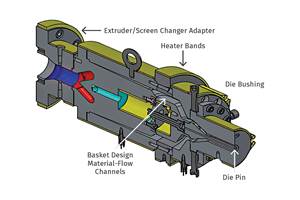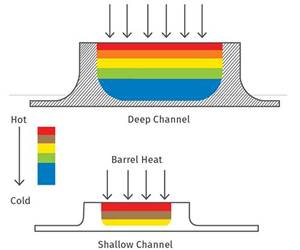Thrifty California Processor Dries PET with 'Waste' Heat
Processor strategies: FDS Manufacturing Co.
Southern California can be a challenging environment for manufacturers, not least because of concerns about the cost and availability of electrical power.
Southern California can be a challenging environment for manufacturers, not least because of concerns about the cost and availability of electrical power. It was a series of brownouts around 10 years ago that got FDS Manufacturing Co. in Pomona thinking about backup diesel generators. But those units can be run only for 500 hr per year, owing to air-emissions rules. It was when FDS installed a 6-in., 4000-lb/hr PET sheet extrusion line with associated crystallizer and dryer a few years ago that the firm began looking
into electrical cogeneration with gas turbines to control energy costs.
“There’s 800 amps for that extruder alone,” says Kevin Stevenson, v.p. of engineering. “But the light bulb really lit up when I realized that the thermal output of a gas turbine—separate from the electrical output—was a perfect match for the Btu requirements of a 4000-lb/hr PET crystallizer or dryer.” That led him to try something that, as far as he knows, has never been done before.
BREAKING NEW GROUND
FDS (fdsmfg.com) is a family-owned firm that was started by Stevenson’s grandfather in 1950 and is run today by his father. It has grown to about $20 million in annual sales to local agricultural markets, producing thermoformed PET fruit trays and clamshell berry boxes, as well as injection molded PP berry baskets and corrugated cardboard rolls, sheets, and pads. It employs around 200 people and operates one extrusion line, six thermoformers, and 12 molding presses of 50 to 300 tons in 250,000 ft² of manufacturing and warehouse space in Pomona, plus another facility in Fowler, Calif.
When he began thinking of gas-turbine power, Stevenson got help from Regatta Solutions in San Juan Capistrano (regattait.com), which is the exclusive distributor in Southern California for Capstone
Turbine Corp. (capstoneturbine.com) in Chatsworth, Calif. Steve Acevedo, Regatta’s president and CEO, says a number of local manufacturers have been taking advantage of the low price of clean-burning natural gas to cut electrical costs and ensure reliable power—an issue that has been highlighted by an
indefinite shutdown of the San Onofre nuclear power generating plant. Despite the high cost of electricity in Southern California, Acevedo recommends that a gas turbine installation be sized for the thermal needs—heating or cooling—of the plant. “There’s your economic justification,” says Acevedo. “The electrical power cogeneration is the icing on the cake.”
For FDS, that “icing” provides about 30% of the Pomona plant’s electrical needs, saving about $30,000 a month. “Average electrical cost here is 16¢/kWh, and we’re cogenerating for 10¢/kWh,” Stevenson says.
In 2008, FDS installed six Capstone turbines of 65-kW capacity each (which cost around $150,000 apiece at today’s prices). The waste heat from four of those turbines passes through an air/water heat exchanger to provide cold process water at 42 to 47 F by means of a salt-solution absorption cooling system. Waste heat from the other two turbines is sent through an air/air heat exchanger to provide all the hot air for an XTLR-4000 crystallizer and 450-ft3 DHD-120 drying hopper, both from Universal Dynamics, Inc., Woodbridge, Va. (unadyn.com). The conversion was achieved with UnaDyn’s assistance. FDS left the original gas burners on this equipment, in case they were ever needed. But they have been running on waste heat 24/7 for three years without a hitch. Stevenson thinks this has never been done before, and UnaDyn sources agree.
Related Content
How To Identify Resin Degradation in Single-Screw Extruders
Degradation can occur in many single-screw extrusion operations, and typically occurs due to minor design flaws in the screw. Here is how to track it down.
Read MoreHow to Select the Right Tooling for Pipe Extrusion
In pipe extrusion, selecting or building a complementary set of tooling often poses challenges due to a range of qualitative factors. Here’s some guidance to help you out.
Read MorePart 2 Medical Tubing: Use Simulation to Troubleshoot, Optimize Processing & Dies
Simulation can determine whether a die has regions of low shear rate and shear stress on the metal surface where the polymer would ultimately degrade, and can help processors design dies better suited for their projects.
Read MoreThe Importance of Barrel Heat and Melt Temperature
Barrel temperature may impact melting in the case of very small extruders running very slowly. Otherwise, melting is mainly the result of shear heating of the polymer.
Read MoreRead Next
Making the Circular Economy a Reality
Driven by brand owner demands and new worldwide legislation, the entire supply chain is working toward the shift to circularity, with some evidence the circular economy has already begun.
Read MoreLead the Conversation, Change the Conversation
Coverage of single-use plastics can be both misleading and demoralizing. Here are 10 tips for changing the perception of the plastics industry at your company and in your community.
Read More











